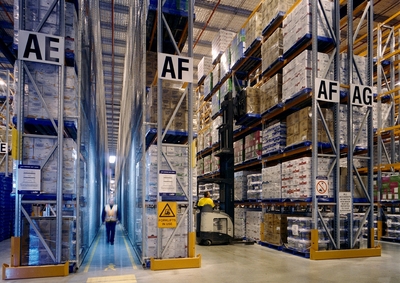New racking standard brings Australia up to date
Tuesday, 26 June, 2012
A new standard covering the design of steel storage racking systems was released on 29 February 2012, after the previous standard remained unchanged for 18 years. The new standard is called AS4084-2012 Steel Storage Racking. Dr Murray Clarke, Structural Design Manager, Dematic, discusses some of the key changes in the standard.
The new standard will bring Australia up to date with the latest international knowledge and experience in the design of storage systems and cold-formed steel structures.
Racking is a system, not a product

Even though each component of a steel racking system may be a ‘standard’ component, compliance with the standard depends on how these components interconnect to make a system, the level of load it is required to hold, the presence or absence of seismic loads and so on. Essentially, compliance with AS4084-2012 is a rack-by-rack, application-dependent proposition.
While the designer is responsible for ensuring the steel racking systems are fit for purpose, meet the user’s requirements and budget, and provide acceptable safety margins to ensure safe, long-term operation, the responsibility of ensuring the systems are properly used and maintained falls squarely on the user.
Key changes to design
The major change to the Australian steel storage racking standard is the switch from using a “permissible stress” design philosophy to a “limit states” design approach. This change brings the Australian standard into line with most of the advanced rack design codes in the world, including the European racking standard EN15512:2009 and the Rack Manufacturers Institute Specification from North America. It also brings the standard into line with the relevant cross-referenced companion Australian standards including AS/NZS4600:2006 Cold Formed Steel Structures and AS4100-1998 Steel Structures.
From a structural design perspective, the limit states approach offers advantages over the permissible stress format. It allows the designer to consider the application of different margins of safety to different types of loads (dead loads, storage loads, live loads, seismic loads) to facilitate design optimisation, while guaranteeing a prescribed level of safety across different combinations of loads. Limit states design also provides the designer with better insight into how the structure will behave in the event of an overload that approaches the true collapse load of the system.
Other changes in the new standard include expanded and improved testing provisions, including statistical evaluation, and the inclusion of advanced methods of structural analysis and finite element analysis.
Compared to the 1993 standard, the new standard has the potential to result in more structurally efficient and finely tuned designs. The result is that modern storage racks are generally lighter and cheaper than older racks, while still possessing the required minimum level of structural safety - good news for end users.
Key changes to operational requirements and end-user responsibilities
Users should be aware of a number of important changes:
- No changes to storage system configuration are allowed without the approval of the equipment supplier or a structural engineer.
- The vertical clearance requirement for pallets stored above heights of 6 m has been increased from 75 to 100 mm. This is aimed at reducing the risk of accidental impact with beams during pallet put-away and retrieval.
- The ‘flue space’ between pallets backing on to each other has been increased by 50 mm, reducing the risk of an adjacent pallet being accidentally dislodged when storing or retrieving pallets. This increase in flue space also better accommodates the needs of insurance companies who often insist on a minimum flue space of 75 mm to allow adequate penetration of water from roof and rack-mounted sprinklers during a fire.
- A minimum of two ground anchors must be used per baseplate on racks where forklifts are used.
- Minor changes to rack load signage whereby the dimension from ground to first beam level and from first to second beam level must be noted explicitly on signs.
User responsibilities
Storage system users should ensure their systems are professionally audited each year. Many storage system users are either unaware or routinely ignore these requirements.
Recent rack collapses in New Zealand have shown the importance of regular system audits to identify existing rack damage that could compromise performance during a seismic event or overloading of the structure.
Failure to conduct annual audits could expose users to litigation and potential penalties should an incident occur.
What the standard doesn’t cover
Like the standard before it, the new steel storage racking standard is only relevant for closed-face racks such as ‘selective’, ‘narrow-aisle’ and ‘double deep’ racking. It does not cover open-face racks such as ‘drive-in’ or ‘cantilever’ racking.
When designing open-face racks, designers will need to seek guidance from other international standards and codes such as FEM 10.2.07 for drive-in racking and FEM 10.2.09 for cantilever racking. These codes can be used in conjunction with AS/NZS4600-2005 Cold Formed Steel Structures to obtain structurally sound racking designs consistent with best practice.
The great bottle battle - Coke vs Pepsi
Coke took Pepsi to court in Australia, alleging that the release of Pepsi's glass...
COAG report rejects container deposit scheme
The highly contentious container deposit scheme (CDS) has been rejected by a COAG report as being...
Everyone who is anyone in the food industry will be exhibiting at AUSPACK 2015
With AUSPACK less than three months away the expansive line-up of multinational as well as...











